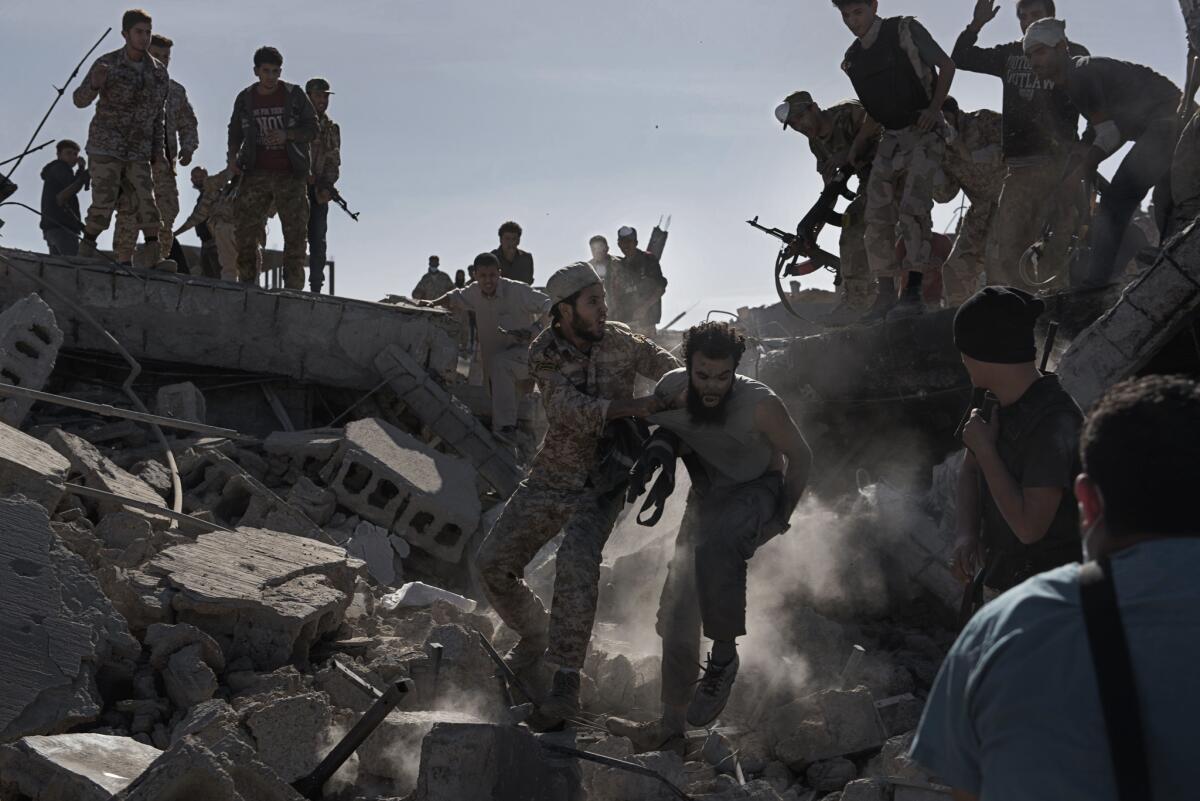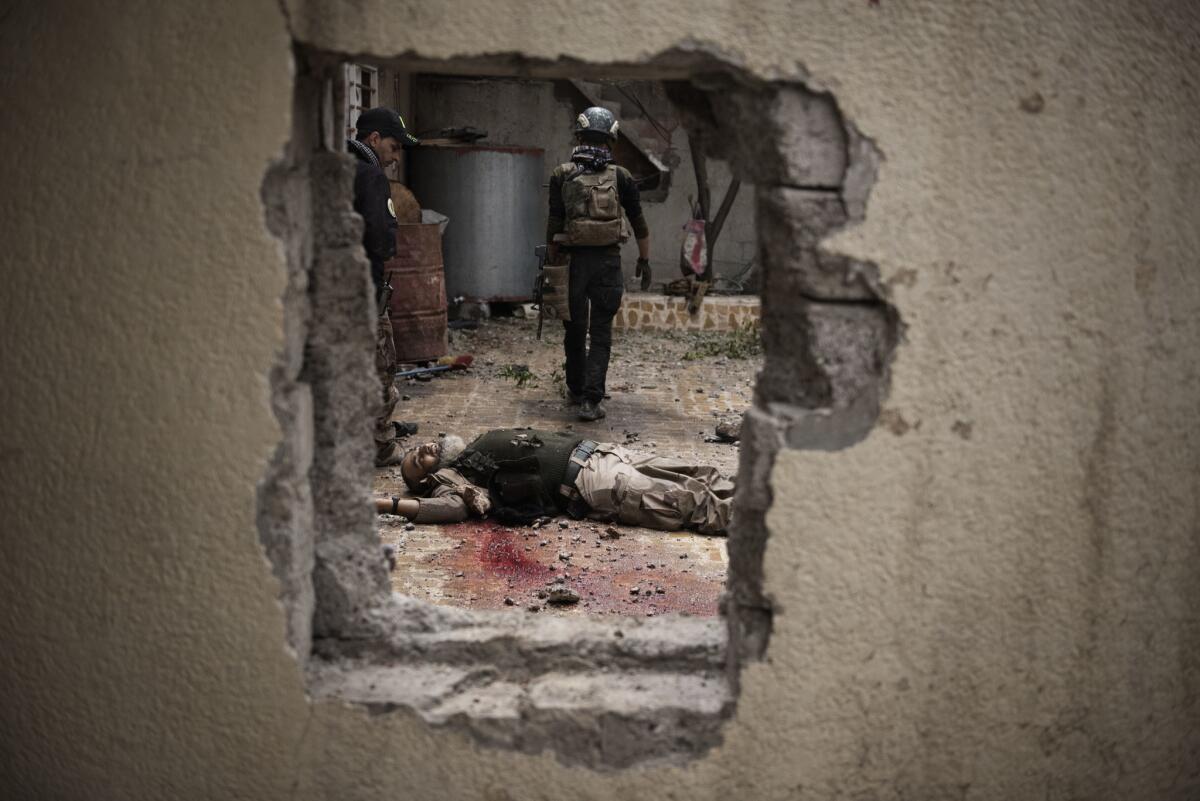War photographer Alessio Romenzi on covering conflict and managing his fear
- Share via
Photographer Alessio Remenzi has been covering conflict in the Middle East since the
How did you decide to cover the conflict in Iraq?
I decided to cover the Mosul offensive for several reasons. The first is certainly that the so-called
You’ve mentioned previously that being on a battlefield is like “walking in a modern archaic era. When man is exposed to such events, he gets straight back to his animal origins.” Have your feelings changed about documenting this and how you approach it?
I think this is increasingly true, especially in a war like this one. The Mosul war is an urban war, a war characterized by booby traps, snipers, car bombs. A grinding urban warfare that, most probably, will become fiercer in the coming weeks.

Several months ago I lived a dramatically iconic situation in Libya: The day before the end of the war in Sirte, I got access to the front line. During the weeks journalists' access was very limited, and the reason was that the Libyan soldiers have not taken prisoners, they killed all the ISIS fighters they captured. The day before the end of the war, a group of Libyan soldiers dragged out of the rubble a young ISIS fighter, his face was hollowed by hunger and he was disarmed. They did not notice my presence and I could document the moment in which they shot this guy. After a few minutes his body was lying on the ground. That moment — that shot — represented for me a bit the idea of barbarism, violence brought to its primordial and animal roots, a violence in which there are no more rules or ethics to be respected. There is only blind rage and blood. The Mosul war has the same characteristics, amplified. When you realize that a car bomb is approaching, your fear and the horror in the eyes of the soldiers who are with you are no longer human and rational. Everything suddenly becomes animal.
What is it like working inside of Iraq? How does it compare to Syria and other places you have covered in the region?
I can compare two wars I have covered in the last year. In Libya, in Sirte, there were only a dozen reporters and photographers; the media coverage has been low for the whole duration of the conflict. This gave me the chance to deepen several shades of that war: everyday life in the field hospitals, I shared life with the soldiers for weeks, I shared with them a mattress on the ground and the little food that reached the front line. I had time to see for weeks the long empty days, the endless waiting of the soldiers, images and feelings different from the collective imagination about war. I think that in the work of the photographer, especially the war photographer, this is very important: Loneliness and time create concentration and awareness, and also give you the opportunity to ask yourself specific questions on what you have in front of you.
From this point of view, the war in Mosul is very different. It is a mainstream war. At the beginning of the offensive, in November, the number of journalists present in Mosul was impressive. Today in western Mosul there is a media center that brings journalists to the front line, showing them the symbolic places of the battle. This emphasizes how communication is important today in Iraq. In Mosul there is a real army, an army who has a clear hierarchy and a clear chain of command. In Sirte, in Libya, there were dozens of militias, with one common goal — to liberate the city from ISIS control — but divided by the idea of the future of the country. In Syria, the situation was similar.
You said in 2012 that "focusing on the situation at hand” helped you to manage your fear. Has that strategy changed over the years?
No, it hasn’t changed at all.
When I live in dangerous situations, I value every detail around me: every sound, the tone of the voices, the moods of the people around me. I remind myself that the fear must help me to decide my movements and my choices. Especially in wars like this, where it is impossible to predict the act of a suicide bomber or a car bomb coming in your direction, where danger can come even in moments of apparent calm, you must always remain aware, vigilant. Anything can happen in the front line. It's a war.

But I also believe that each of us carry within himself at least one image that he has chosen not to take because it would be too dangerous. This work is also made of images seen, lived and not taken.
What would you like to cover over the next few years?
I would like to focus on how the war against terrorism will affect everyday life. I believe that big changes are already evident in the war zones where we work. And I think that a photographer is also a storyteller. And since these times require us to think about the potential and the limits of the photographic medium, I'd like to extend this reasoning to the limits that this type of terrorism brings to our lives and our work.
Civilians who escaped Mosul are gathered at a facility on the outskirts of the city before being screened for Islamic State infiltrators and transferred to displaced persons camps.
Smoke rises from a bombed area behind a cemetery in western Mosul.
Burned-out cars are stepping stones for a resident of the heavily damaged Wadi Ajar neighborhood of Mosul.
Civilians escaping west Mosul.
Civilians wheel a body from a newly liberated area in west Mosul.
After escaping Mosul, a resident is questioned by Iraqi soldiers seeking information about the location of Islamic State fighters in the city.
Refugees who fled west Mosul warm themselves at night in Kaysumah village. Iraqi army vehicles will take them to displaced persons camps in the coming days.
Sign up for Essential California
The most important California stories and recommendations in your inbox every morning.
You may occasionally receive promotional content from the Los Angeles Times.







